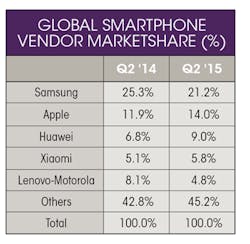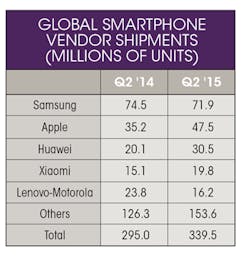Smartphone Market Slugs Lowest Growth Rate Since Recession
The global smartphone market has recorded its slowest annual growth rate in over five years, according to financial results from the second quarter of 2015. A report from research firm Strategy Analytics found that smartphone shipments have only increased by 15.1% over the last year, compared to 26.6% over the previous year.
The smartphone market has not grown so slowly since the depths of the economic recession. Around 339.5 million units were sold in the second quarter this year, whereas 295 million units were sold in the second quarter of 2014. Linda Sui, director of wireless smartphone strategies at Strategy Analytics, noted that this could be attributed to high penetration rates in the American, Chinese, and European markets.
The smartphone market is highly saturated in these regions. Fewer people have an incentive to purchase a new smartphone because they already own one. Countries with few smartphone owners, like India, are expected to become major growth areas in the next few years. At the same time, rapid growth in China and the U.S. is slowing down.
Samsung shipped 71.9 million smartphones in the second quarter of this year, capturing 21.2% of the market. Although the South Korean firm retained the largest share of the global market, it experienced a more than 4% decline since last year. Neil Mawston, an executive director at Strategy Analytics, noted that the company was hurt by intense competition from Chinese brands in the low-end market, while it underestimated demand for its flagship S6 Edge in the high-end market.
Apple and Huawei Technologies, on the other hand, significantly increased the number of units sold in the second quarter, with both manufacturers recording slight gains in the market. Apple shipped around 47.5 million units and captured 14% of the market, as consumers upgraded to the iPhone 6 and iPhone 6 Plus. Apple smartphones also remained "wildly popular" in China, Mawston said. Huawei carved out around 9.0% of the market, expanding in Asia and North America.
The report said that smartphone manufacturers will have to enact major design changes in order to revitalize growth in saturated markets. Sui suggested manufacturing displays that were flexible enough to be folded and rolled. Samsung introduced this flexible display technology at the International Consumer Electronics Show in 2013, but the company has not announced when it could appear in phones.
About the Author
James Morra
Senior Editor
James Morra is the senior editor for Electronic Design, covering the semiconductor industry and new technology trends, with a focus on power electronics and power management. He also reports on the business behind electrical engineering, including the electronics supply chain. He joined Electronic Design in 2015 and is based in Chicago, Illinois.


